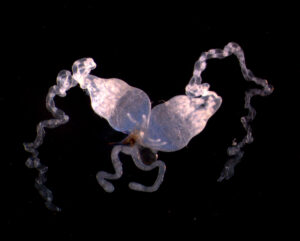GAELEN BURKE

Gaelen Burke, Ph.D., is an Assistant Professor in the Department of Entomology in the College of Agriculture and Environmental Science at the University of Georgia. She received her B.S. at the University of Queensland in Australia, and completed her Ph.D. degree at the University of Arizona in Ecology and Evolutionary Biology.
Hereditary symbiosis is a common mechanism by which eukaryotic hosts can acquire traits beneficial for their fitness. Many insects have symbiotic associations with bacteria that trace back millions of years, whose function and evolution are well characterized. Insects can also possess more recently derived symbionts that are closely related to free-living bacteria, and often play a role in host defense. My dissertation focused upon Serratia symbiotica, a recently derived symbiont that infects aphids and provides protection against heat stress, and possibly also plays a nutritional role. I studied several aspects of the biology of recent symbionts, including the diversity of functional roles and evolution among hosts for single lineages of symbionts, the molecular mechanisms that contribute to defense, the early stages of symbiont genome evolution, and interactions with hosts.
While bacteria are well recognized to form beneficial symbiotic associations with metazoans, viruses are usually viewed as non-living, parasitic entities that interact with hosts in ways that only benefit their own transmission and persistence. Parasitoid wasps have viruses that have been associated with their hosts for 100 million years, and have evolved to be beneficial symbionts. These polydnaviruses (PDVs) are essential to the survival of the wasp’s offspring, which depend upon PDV gene products that suppress host immune defenses.
PDV persists as an integrated provirus in wasps, and is transmitted through the germ line, while replication to form virus particles only occurs in the reproductive tract of female wasps. Little is currently known about how virus- and wasp-derived genes interact to regulate viral replication and maintain the symbiotic association. For the past several years I, along with my postdoctoral advisor Dr. Mike Strand, have focused upon the wasp Microplitis demolitor and its associated polydnavirus named M. demolitor bracovirus (MdBV).


